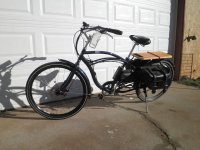idealistix
1 mW
- Joined
- May 16, 2015
- Messages
- 10
I am going to build my first commuter e-bike. I have already spent a ton of time on ES, but would like some feedback on my plans. My one way commute is 9 miles, but a longer 10 mile route is probably safer.
I am an engineer, so I cannot help but go about this build in a methodical manner. Decisions step A (see below) will get me to finalize the specifications for the e-bike. Step B will be details on how to actually build it.
Here are my requirements:
Budget: $1,500 for conversion (can go up to $1,800 if needed)
Cruising speed: 25 mph
Max speed: 30+ mph
Terrain: mostly flat, some rolling hills
Range at 25 mph: 20 miles (12 mile range may be ok if I am able to charge the batteries at work)
Rider + cargo weight: 150 lbs
Stealth factor: high (I will need to ride on some sidewalks which is legal in my city, but I'd rather not attract unwanted attention)
Wheel size: 700c / 26"
Brake type: rim if using current bike
Current bike: Trek Verve 1 (http://www.trekbikes.com/us/en/bikes/city/recreation/verve/verve_1/)
Battery chemistry: must be very safe
Upgrade options: I want an "open" system so I can upgrade components easily in the future
Decisions step A:
1. Use my existing bike (Trek Verve 1) or get a different one off craigslist?
2. Rear hub or mid-drive? (I have ruled out front hub)
3. Direct drive or geared?
4. Motor output?
5. System voltage?
6. Battery type?
7. Battery capacity?
Decisions step B (only after I have completed step A above):
1. Brand of motor / conversion kit?
2. Brand of battery?
3. How to mount the battery?
4. Full list of parts to complete build?
5. Vendor(s) to buy from?
My initial thoughts for step A:
1. Use existing bike (Trek Verve 1) - it fits me great, is light weight, and is in good condition. However it does not have disc brakes or shock absorbers. I will ride mostly on smooth roads or sidewalk, so shock absorbers are probably not important.
2. Rear hub - Stealthier, more reliable than mid-drive
3. Direct drive - Quieter, more reliable, tends to be more powerful. I can leave electric assist on (at the lowest setting) to overcome motor resistance even when I am primarily pedaling . I am also fine with slower acceleration and don't have steep hills.
4. Motor output - 1,000W minimum, 1,500W preferred
5. System voltage - 48V, 30A continuous
6. Battery type - LiFePO4
7. Battery capacity - 15AH (maybe 10AH if significantly cheaper / lighter)
I welcome your feedback / recommendations to help my build go smoothly!
I am an engineer, so I cannot help but go about this build in a methodical manner. Decisions step A (see below) will get me to finalize the specifications for the e-bike. Step B will be details on how to actually build it.
Here are my requirements:
Budget: $1,500 for conversion (can go up to $1,800 if needed)
Cruising speed: 25 mph
Max speed: 30+ mph
Terrain: mostly flat, some rolling hills
Range at 25 mph: 20 miles (12 mile range may be ok if I am able to charge the batteries at work)
Rider + cargo weight: 150 lbs
Stealth factor: high (I will need to ride on some sidewalks which is legal in my city, but I'd rather not attract unwanted attention)
Wheel size: 700c / 26"
Brake type: rim if using current bike
Current bike: Trek Verve 1 (http://www.trekbikes.com/us/en/bikes/city/recreation/verve/verve_1/)
Battery chemistry: must be very safe
Upgrade options: I want an "open" system so I can upgrade components easily in the future
Decisions step A:
1. Use my existing bike (Trek Verve 1) or get a different one off craigslist?
2. Rear hub or mid-drive? (I have ruled out front hub)
3. Direct drive or geared?
4. Motor output?
5. System voltage?
6. Battery type?
7. Battery capacity?
Decisions step B (only after I have completed step A above):
1. Brand of motor / conversion kit?
2. Brand of battery?
3. How to mount the battery?
4. Full list of parts to complete build?
5. Vendor(s) to buy from?
My initial thoughts for step A:
1. Use existing bike (Trek Verve 1) - it fits me great, is light weight, and is in good condition. However it does not have disc brakes or shock absorbers. I will ride mostly on smooth roads or sidewalk, so shock absorbers are probably not important.
2. Rear hub - Stealthier, more reliable than mid-drive
3. Direct drive - Quieter, more reliable, tends to be more powerful. I can leave electric assist on (at the lowest setting) to overcome motor resistance even when I am primarily pedaling . I am also fine with slower acceleration and don't have steep hills.
4. Motor output - 1,000W minimum, 1,500W preferred
5. System voltage - 48V, 30A continuous
6. Battery type - LiFePO4
7. Battery capacity - 15AH (maybe 10AH if significantly cheaper / lighter)
I welcome your feedback / recommendations to help my build go smoothly!




